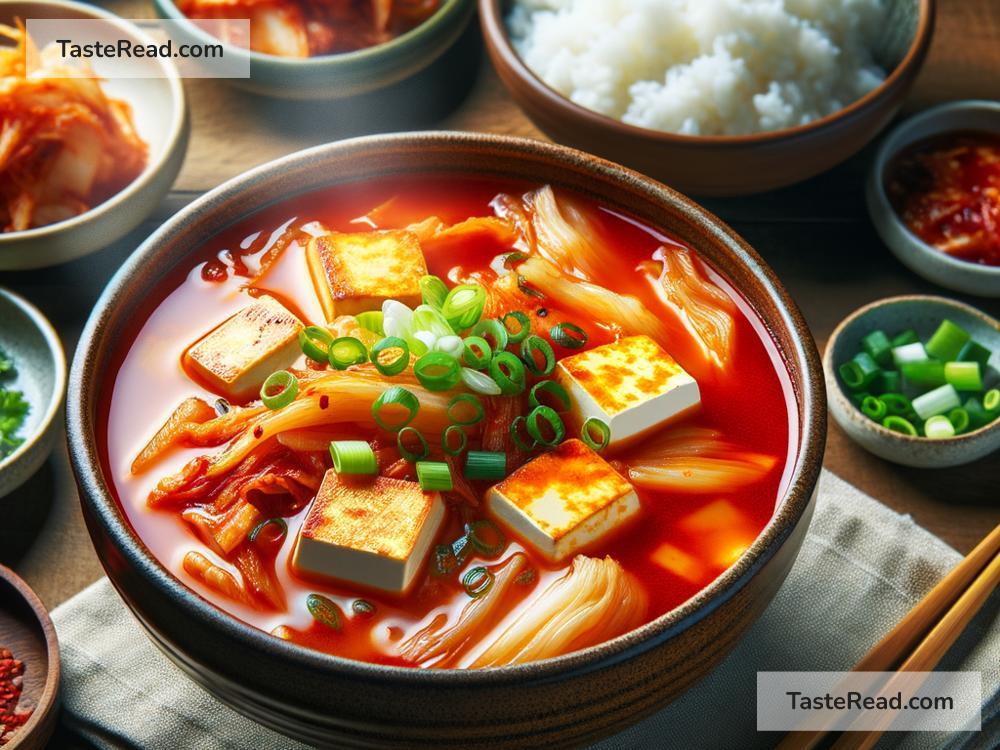The Story of Korean Kimchi Jjigae: A Comfort Food with a Rich History
Kimchi jjigae is one of Korea’s most beloved dishes. It is a warm, spicy stew made with kimchi, tofu, pork (or other protein), and vegetables. While simple, it carries deep history and meaning for Koreans. Across generations, this dish has become a staple in Korean homes, representing delicious food, family traditions, and resilience during hard times.
What is Kimchi Jjigae?
Kimchi jjigae is a soup-like dish that features kimchi, Korea’s famous fermented cabbage. Kimchi is seasoned with chili powder, garlic, ginger, fish sauce, and other ingredients, and its flavor becomes stronger as it ferments. Similar to how sourdough bread changes over time, kimchi gets more flavorful the longer it sits. Kimchi jjigae commonly uses older, extra-fermented kimchi. Its tangy, bold flavor makes the stew even tastier.
The base of kimchi jjigae is a broth made with water or stock, often enhanced with gochugaru (Korean red chili powder) and sometimes gochujang (Korean chili paste). Alongside kimchi, typical ingredients in the stew include tofu, sliced pork belly, green onions, garlic, and sometimes mushrooms.
Origins: A Dish Built on Everyday Life
Kimchi jjigae evolved naturally from kimchi, which has been a central part of Korean cuisine for hundreds of years. Kimchi itself dates back over a thousand years, when Koreans developed different ways to preserve vegetables during the colder months. Its tangy, spicy flavor became a foundation for many Korean dishes, and kimchi jjigae eventually emerged as a way to use leftover and aged kimchi.
The dish likely became popular because it allowed people to turn simple ingredients into something hearty and flavorful. When resources were limited, Koreans used aged kimchi, scraps of pork, and whatever vegetables they had on hand to create this comforting meal. Over time, kimchi jjigae grew into one of Korea’s most iconic dishes.
Cooking Kimchi Jjigae: Family Traditions on the Stove
Ask any Korean household and they will tell you their recipe for kimchi jjigae is the best! What makes the dish so unique is that everyone puts their own twist on it. Some families prefer to use pork belly for richness, while others use canned tuna or beef. Some people add extra spice, while others like a milder version.
The basic process is simple. First, the kimchi is sautéed in the pot to deepen its flavor. Then water or broth is added along with the protein of choice, such as pork, tuna, or tofu. Vegetables like green onions or zucchini are commonly included. The stew simmers, allowing the flavors to meld together. It is often served hot and bubbling in a communal pot at the table, accompanied by a bowl of rice and side dishes.
For Koreans, kimchi jjigae feels like home. Parents pass recipes on to their children, and the variations reflect the personalities and tastes of each family. It is a dish that brings people together, creating moments of joy, warmth, and connection.
Kimchi Jjigae’s Resilience in Hard Times
Kimchi jjigae is more than just food—it is a dish with heart and soul. Historically, Korea has faced many challenges, from wars to periods of poverty. During hard times, kimchi jjigae helped people make the most of what they had. Even with simple ingredients, it brought comfort to families.
After the Korean War in the 1950s, Korea struggled with economic hardships. People had limited access to meat and fresh vegetables. As a result, kimchi jjigae became a practical way to stretch ingredients. Leftover kimchi, a handful of tofu, and scraps of pork created a flavorful, filling meal that nourished both body and spirit.
Today, this humble dish continues to represent strength and resilience. It is a reminder of how Koreans have persevered over the years, finding ways to celebrate their culture and create delicious meals even during challenging times.
Kimchi Jjigae Around the World
As Korean cuisine gains popularity globally, kimchi jjigae has found fans far beyond its homeland. Korean restaurants worldwide serve the dish to introduce people to its bold, comforting flavors. Many people have also started making kimchi jjigae at home, thanks to the growing availability of kimchi and Korean ingredients.
For first-timers, kimchi jjigae can be a surprising experience. Its bold flavors—spicy, tangy, and savory all at once—may feel unusual to those unfamiliar with fermented foods. However, once you take a few bites, you’ll discover its warmth and depth, which make it hard to resist.
Conclusion: A Taste of Tradition and Comfort
Kimchi jjigae is more than just a bowl of stew; it is a dish full of history, family traditions, and cultural pride. From its humble beginnings to its modern-day popularity, it represents the heart of Korean cuisine. Whether you’re eating it on a cold winter day or sharing it with friends, kimchi jjigae offers comfort, connection, and a taste of Korea’s spirit.
So next time you see kimchi jjigae on a menu or find some kimchi in your refrigerator, give it a try. You’ll be enjoying a dish that has nourished Korean families for generations—a dish that tells a story of resilience and togetherness, all in a warm, bubbling pot.


